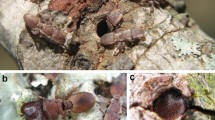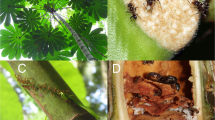Abstract
The evolution of colony size in social insects is influenced by both extrinsic and colony-intrinsic factors. An important intrinsic trait, per-capita productivity, often declines in larger colonies. This pattern, known as Michener’s paradox, can limit the growth of insect societies. In this study, we first describe this problem, survey its occurrence across different ant species, and present a case study of eight cavity-dwelling ants with very small colony sizes. In these species, colonies might never reach sizes at which per-capita productivity decreases. However, in six out of the eight focal species, per-capita productivity did decline with increasing size, in accordance with other studies on per-capita productivity in ants. Several mechanisms, such as resource availability or nest-site limitation, may explain the decrease in per-capita productivity with increases in colony size in our focal species. In these central-place foragers, the individual foraging mode is expected to lead to an increase in travel time as colonies grow. We suggest that polydomy, the concomitant occupation of several nest sites, could serve as a potential strategy to overcome this limitation. Indeed, for one species, we show that polydomy can help to circumvent the reduction in productivity with increasing colony size, suggesting that limited resource availability causes the observed decrease in per-capita productivity. Finally, we discuss the influence of other factors, such as the nesting ecology and colony homeostasis, on the evolution of colony size in these cavity-dwelling ants.




Similar content being viewed by others
References
Alloway TM (1979) Raiding behavior of 2 species of slave-making ants, Harpagoxenus americanus (Emery) and Leptothorax duloticus Wesson (Hymenoptera, Formicidae). Anim Behav 27:202–210
Beckers R, Goss S, Deneubourg JL, Pasteels JM (1989) Colony size, communication and ant foraging strategy. Psyche 96:239–256
Billick I (2001) Density dependence and colony growth in the ant species Formica neorufibarbis. J Anim Ecol 70:895–905
Bourke AFG (1999) Colony size, social complexity and reproductive conflict in social insects. J Evol Biol 12:245–257
Breusch TS, Pagan AR (1979) A simple test for heteroscedasticity and random coefficient variation. Econometrica: Journal of the Econometric Society:1287–1294
Brian MV (1953) Brood-rearing in relation to worker number in the ant Myrmica. Physiol Zool 26:355–366
Brian MV (1956) Group form and causes of inefficiency in the ant Myrmica rubra L. Physiol Zool 29(3):173–194
Byrne MM (1994) Ecology of twig-dwelling ants in a wet lowland tropical forest. Biotropica 26:61–72
Cade BS (2003) Quantile regression models of animal habitat relationships. PhD Dissertation, Colorado State University, Fort Collins
Cade BS, Noon BR (2003) A gentle introduction to quantile regression for ecologists. Front Ecol Environ 1:412–420
Cassill D (2002) Yoyo-bang: a risk-aversion investment strategy by a perennial insect society. Oecologia 132:150–158
Chan GL, Hingle A, Bourke AFG (1999) Sex allocation in a facultatively polygynous ant: between-population and between-colony variation. Behav Ecol 10:409–421
Clouse R (2001) Some effects of group size on the output of beginning nests of Mischocyttarus mexicanus (Hymenoptera: Vespidae). Fla Entomol 84:418–425
Cole BJ (1984) Colony efficiency and the reproductivity effect in Leptothorax allardycei (Mann). Insectes Soc 31:403–407
Core Development Team R (2010) R: A language and environment for statistical computing R Foundation for Statistical Computing. Austria, Vienna
DeHeer CJ, Backus VL, Herbers JM (2001) Sociogenetic responses to ecological variation in the ant Myrmica punctiventris are context dependent. Behav Ecol Sociobiol 49:375–386
Dornhaus A, Holley J-A, Franks NR (2009) Larger colonies do not have more specialized workers in the ant Temnothorax albipennis. Behav Ecol 20:922–929
Foitzik S, Heinze J (1998) Nest site limitation and colony takeover in the ant Leptothorax nylanderi. Behav Ecol 9:367–375
Foitzik S, Heinze J (2000) Intraspecific parasitism and split sex ratios in a monogynous and monandrous ant (Leptothorax nylanderi). Behav Ecol Sociobiol 47:424–431
Foitzik S, Herbers JM (2001) Colony structure of a slavemaking ant. I. Intracolony relatedness, worker reproduction, and polydomy. Evolution 55:307–315
Foitzik S, Stratz M, Heinze J (2003) Ecology, life history and resource allocation in the ant, Leptothorax nylanderi. J Evol Biol 16:670–680
Foitzik S, Backus VL, Trindl A, Herbers JM (2004) Ecology of Leptothorax ants: impact of food, nest sites, and social parasites. Behav Ecol Sociobiol 55:484–493
Foitzik S, Achenbach A, Brandt M (2009) Locally adapted social parasite affects density, social structure, and life history of its ant hosts. Ecology 90:1195–1206
Franks NR, Dornhaus A, Best CS, Jones EL (2006) Decision making by small and large house-hunting ant colonies: one size fits all. Anim Behav 72:611–616
Hee JJ, Holway DA, Suarez AV, Case TJ (2000) Role of propagule size in the success of incipient colonies of the invasive Argentine ant. Conserv Biol 14:559–563
Heinze J, Foitzik S, Hippert A, Hölldobler B (1996) Apparent dear-enemy phenomenon and environment-based recognition cues in the ant Leptothorax nylanderi. Ethology 102:510–522
Herbers JM (1986) Nest site limitation and facultative polygyny in the ant Leptothorax longispinosus. Behav Ecol Sociobiol 19:115–122
Herbers JM, Banschbach VS (1999) Plasticity of social organization in a forest ant species. Behav Ecol Sociobiol 45:451–465
Herbers JM, Choiniere E (1996) Foraging behaviour and colony structure in ants. Anim Behav 51:141–153
Herbers JM, Johnson CA (2007) Social structure and winter survival in acorn ants. Oikos 116:829–835
Herbers JM, Stuart RJ (1996) Multiple queens in ant nests: impact on genetic structure and inclusive fitness. Am Nat 147:161–187
Herbers JM, Stuart RJ (1998) Patterns of reproduction in slave-making ants. Proc R Soc Lond B Biol Sci 265:875–887
Hölldobler B, Wilson EO (1990) The ants. Harvard University Press, Cambridge, MA, USA
Hou C, Kaspari M, Vander Zanden HB, Gillooly JF (2010) Energetic basis of colonial living in social insects. Proc Natl Acad Sci U S A 107:3634–3638
Jeanne RL, Nordheim EV (1996) Productivity in a social wasp: per capita output increases with swarm size. Behav Ecol 7:43–48
Jorgensen CD, Porter SD (1982) Foraging behavior of Pogonomyrmex owyheei in Southeast Idaho. Environ Entomol 11:381–384
Jun J, Pepper JW, Savage M, Gillooly JF, Brown JH (2003) Allometric scaling of ant foraging trail networks. Evol Ecol Res 5:297–303
Kaspari M (1996) Testing resource-based models of patchiness in four Neotropical litter ant assemblages. Oikos 76:443–454
Kaspari M, Byrne MM (1995) Caste allocation in litter Pheidole—lessons from plant defense theory. Behav Ecol Sociobiol 37:255–263
Kaspari M, Vargo EL (1995) Colony size as a buffer against seasonality: Bergmann’s rule in social insects. Am Nat 145:610–632
Koenker R (2011) Quantreg: quantile regression. R package version 4.62
Koenker R, Bassett G Jr (1978) Regression quantiles. Econometrica: Journal of the Econometric Society:33–50
Koenker R, Hallock KF (2001) Quantile regression. J Eco Perspect 15:143–156
Kramer BH, Schaible R (2013) Colony size explains the lifespan differences between queens and workers in eusocial Hymenoptera. Biol J Linn Soc 109:710–724
Litte M (1981) Social biology of the polistine wasp Mischocyttarus labiatus: survival in a Colombian rain forest. Smithson Contrib Zool 103:101–127
Michener CD (1964) Reproductive efficiency in relation to colony size in Hymenopterous societes. Insectes Soc 11:317–342
Möglich M (1978) Social organization of nest emigration in Leptothorax (Hym., Form.). Insectes Soc 25:205–225
Naug D, Wenzel J (2006) Constraints on foraging success due to resource ecology limit colony productivity in social insects. Behav Ecol Sociobiol 60:62–68
Oster GF, Wilson EO (1978) Caste and ecology in the social insects. Monographs in Population Biology v. 12. Princeton University Press, Princeton
Palmer TM (2004) Wars of attrition: colony size determines competitive outcomes in a guild of African acacia ants. Anim Behav 68:993–1004
Pamminger T, Scharf I, Pennings PS, Foitzik S (2011) Increased host aggression as an induced defense against slave-making ants. Behav Ecol 22:255–260
Pasquet A, Krafft B (1992) Cooperation and prey capture efficiency in a social spider, Anelosimus eximius (Araneae, Theridiidae). Ethology 90:121–133
Pedersen JS, Boomsma JJ (1999) Genetic analysis of colony structure in polydomous and polygynous ant populations. Biol J Linn Soc 66:115–144
Pohl S, Foitzik S (2011) Slave-making ants prefer larger, better defended host colonies. Anim Behav 81:61–68
Porter SD, Tschinkel WR (1985) Fire ant polymorphism—the ergonomics of brood production. Behav Ecol Sociobiol 16:323–336
Pratt SC, Pierce NE (2001) The cavity-dwelling ant Leptothorax curvispinosus uses nest geometry to discriminate between potential homes. Anim Behav 62:281–287
Queller DC, Goodnight KF (1989) Estimating relatedness using molecular markers. Evolution 43:258–275
Robinson GE (1992) Regulation of division-of-labor in insect societies. Annu Rev Entomol 37:637–665
Scharf I, Bauer S, Fischer-Blass B, Foitzik S (2011a) Impact of a social parasite on ant host populations depends on host species, habitat and year. Biol J Linn Soc 103:559–570
Scharf I, Fischer-Blass B, Foitzik S (2011b) Spatial structure and nest demography reveal the influence of competition, parasitism and habitat quality on slavemaking ants and their hosts. BMC Ecol 11:9
Sorvari J, Hakkarainen H (2007) The role of food and colony size in sexual offspring production in a social insect: an experiment. Ecol Entomol 32:11–14
Stearns SC (1992) The evolution of life histories. Oxford University press, Oxford
Stevens MI, Hogendoorn K, Schwarz MP (2007) Evolution of sociality by natural selection on variances in reproductive fitness: evidence from a social bee. BMC Evol Biol 7:153
Strätz M, Heinze J (2004) Colony structure and sex allocation ratios in the ant Temnothorax crassispinus. Insectes Soc 51:372–377
Stuart RJ, Alloway TM (1988) Aberrant yellow ants: North American Leptothorax species as intermediate hosts of cestodes. In: Advances in myrmecology. E.J. Brill, Leiden, pp 537–545
Sudd JH, Franks NR ( 1987) The behavioural ecology of ants. Chapman & Hall, New York
Tindo M, Kenne M, Dejean A (2008) Advantages of multiple foundress colonies in Belonogaster juncea juncea L.: greater survival and increased productivity. Ecol Entomol 33:293–297
Tschinkel WR (1993) Sociometry and sociogenesis of colonies of the fire ant Solenopsis invicta during one annual cycle. Ecol Monogr 63:425–457
Tschinkel WR (1999) Sociometry and sociogenesis of colony-level attributes of the Florida harvester ant (Hymenoptera: Formicidae). Ann Entomol Soc Am 92:80–89
Wang J (2011) COANCESTRY: a program for simulating, estimating and analysing relatedness and inbreeding coefficients. Mol Ecol Resour 11:141–145
Waters JS, Holbrook CT, Fewell JH, Harrison JF (2010) Allometric scaling of metabolism, growth, and activity in whole colonies of the seed-harvester ant Pogonomyrmex californicus. Am Nat 176:501–510
Wcislo WT, Tierney SM (2009) The evolution of communal behavior in bees and wasps: an alternative to eusociality. In: Gadau J, Fewell J (eds) Organization of insect societies: from genome to sociocomplexity. Harvard University Press, Harvard, pp 148–169
Wenzel JW, Pickering J (1991) Cooperative foraging, productivity, and the central-limit-theorem. Proc Natl Acad Sci U S A 88:36–38
Wilson EO (1974) The population consequences of polygyny in the ant Leptothorax curvispinosus Mayr. Ann Entomol Soc Am 67(5):781–786
Yip EC, Powers KS, Aviles L (2008) Cooperative capture of large prey solves scaling challenge faced by spider societies. Proc Natl Acad Sci U S A 105:11818–11822
Acknowledgments
We thank the many students and collaborators who helped to collect these raw data: Alexandra Achenbach, Miriam Brandt, Sabine Bauer, Birgit Fischer, Joan M. Herbers, and Michaela Strätz. We would also like to thank two anonymous reviewers and Naomi Paz for her help in English editing. BHK would like to thank the Max Planck Institute for demographic research for funding his research.
Conflict of interest
The authors declare no conflict of interest.
Author information
Authors and Affiliations
Corresponding author
Additional information
Communicated by D. Naug
Appendix
Appendix
Rights and permissions
About this article
Cite this article
Kramer, B.H., Scharf, I. & Foitzik, S. The role of per-capita productivity in the evolution of small colony sizes in ants. Behav Ecol Sociobiol 68, 41–53 (2014). https://doi.org/10.1007/s00265-013-1620-8
Received:
Revised:
Accepted:
Published:
Issue Date:
DOI: https://doi.org/10.1007/s00265-013-1620-8




